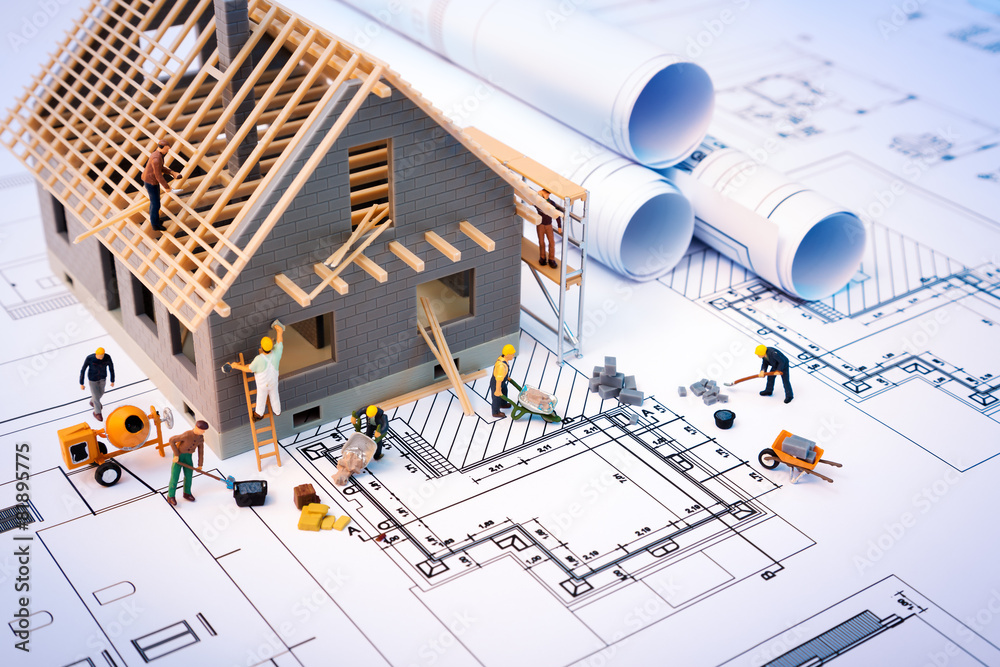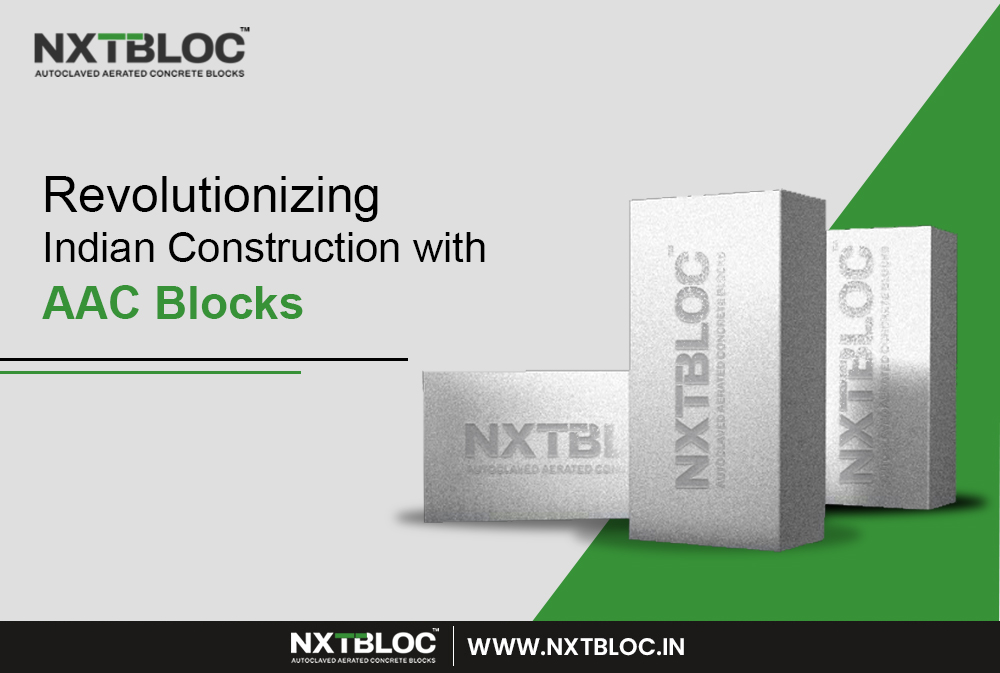The Indian construction industry is booming. With a rapidly growing population and increasing urbanization, the demand for new homes, offices, and infrastructure is at an all-time high. However, traditional building methods often face challenges like slow construction times, high labour costs, and environmental concerns. This is where Autoclaved Aerated Concrete (AAC) blocks come in, offering a revolutionary solution for Indian construction.

Table of Contents
What are AAC Blocks?
AAC blocks, also known as Autoclaved Aerated Concrete blocks, are lightweight, pre-cast building materials made with a combination of sand, fly ash, lime, cement, and water. Through a unique process involving pressurized steam curing (autoclaving), the mixture forms a lightweight and cellular concrete material with numerous advantages over traditional bricks and concrete blocks.
Why AAC Blocks are Perfect for Indian Construction
AAC blocks offer a multitude of benefits that make them a perfect fit for the evolving needs of Indian construction. Let’s examine some of the key advantages in more detail.:

- Faster Construction: AAC blocks are lightweight and easy to work with. They can be cut, drilled, and shaped with simple tools, significantly reducing construction time compared to traditional bricks or concrete blocks. This faster construction translates to quicker project completion and faster occupancy for homes and businesses.
- Reduced Labor Costs: The ease of handling and working with AAC blocks reduces the need for skilled labour on construction sites. Additionally, the larger size of AAC blocks compared to bricks allows for faster wall construction, requiring fewer workers. This translates to lower overall labour costs for Indian construction projects.
- Superior Thermal Insulation: One of the most significant advantages of AAC blocks is their excellent thermal insulation properties. The air pockets within the cellular structure of the block create a natural barrier against heat transfer. This translates to cooler interiors during hot summers and warmer interiors during cold winters. This benefit is particularly crucial for India’s diverse climate, leading to significant energy savings on heating and cooling costs for building occupants.
- Improved Sound Insulation: The cellular structure of AAC blocks also provides excellent sound insulation. This is a valuable advantage in densely populated areas or near busy roads, creating a quieter and more peaceful living or working environment.
- Lightweight Construction: AAC blocks are significantly lighter than traditional bricks and concrete blocks. This lighter weight translates to several advantages:
- Reduced Structural Load: Lighter walls built with AAC blocks put less strain on the building’s foundation, allowing for potentially thinner foundations and overall lighter building structures. This is particularly beneficial in earthquake-prone regions of India.
- Easier Transportation: The lower weight of AAC blocks makes them easier and more cost-effective to transport from manufacturing facilities to construction sites.
- High-Rise Buildings: The lighter weight of AAC block construction makes them suitable for building higher structures without requiring excessively reinforced foundations, opening doors for more efficient use of land space in urban areas.

- Fire Resistance: AAC blocks are a fire-resistant material. They can withstand high temperatures for extended periods, offering an extra layer of safety for building occupants in case of fire.
- Environmentally Friendly: AAC block production uses fly ash, a waste product from coal-fired power plants. This reduces the need for landfill space and promotes sustainable construction practices. Additionally, the lower energy consumption required for AAC block production compared to traditional bricks and the improved energy efficiency of buildings constructed with AAC blocks contribute to a reduced environmental footprint for Indian construction.
- Design Flexibility: AAC blocks are easy to cut and shape, offering architects and builders greater design flexibility. This allows for the creation of unique architectural features and layouts.
Overcoming Challenges for Wider Adoption in Indian Construction
Despite the numerous advantages, there are still some challenges to wider adoption of AAC blocks in Indian construction:
- Lack of Awareness: There is a need for increased awareness among architects, builders, and homeowners about the benefits of AAC blocks. Educational initiatives and demonstrations showcasing the advantages of AAC block construction can help overcome this challenge.
- Skilled Workforce: While AAC blocks are easier to work with than traditional materials, some level of training is needed for construction workers to ensure proper handling and installation techniques. Upskilling initiatives can help address this need.
- Initial Cost Perception: In some cases, AAC blocks may have a slightly higher initial cost compared to traditional bricks. However, the long-term benefits in terms of faster construction, reduced labour costs, and energy savings can outweigh the initial cost difference.
The Future of AAC Blocks in Indian Construction
With their numerous advantages and growing awareness, AAC blocks are poised to revolutionize Indian construction. As the construction industry embraces sustainability, faster construction times, and energy efficiency, AAC blocks are expected to play a major role in shaping the future of Indian buildings.

Here are some additional factors that will contribute to the wider adoption of AAC blocks in India:
- Government Initiatives: Government policies promoting sustainable construction practices can incentivize the use of AAC blocks. This could involve tax breaks for builders using AAC blocks, subsidies for AAC block manufacturers, or public awareness campaigns highlighting the benefits of sustainable building materials.
- Technological Advancements: Continuous research and development in AAC block technology can lead to further improvements in their properties, such as even lighter weight or enhanced fire resistance. Additionally, advancements in manufacturing processes can lead to even more cost-effective AAC block production.
- Focus on Green Buildings: The growing focus on green buildings and sustainable construction in India will create a strong demand for eco-friendly building materials like AAC blocks. As environmental concerns become a higher priority, AAC blocks with their lower environmental impact will become a more attractive choice for builders and developers.
The Role of Consumers:
Consumers also play a crucial role in driving the adoption of AAC blocks. By educating themselves about the benefits of AAC block construction and requesting builders to use them, consumers can influence the construction industry towards more sustainable and efficient practices.
Conclusion
AAC blocks offer a revolutionary solution for Indian construction. With their numerous advantages, from faster construction times and reduced labour costs to superior thermal insulation and environmental friendliness, AAC blocks are poised to play a major role in shaping the future of Indian buildings. By overcoming challenges like a lack of awareness and promoting wider adoption through government initiatives, technological advancements, and consumer demand, AAC blocks have the potential to revolutionize Indian construction, making it faster, more cost-effective, and more sustainable.
